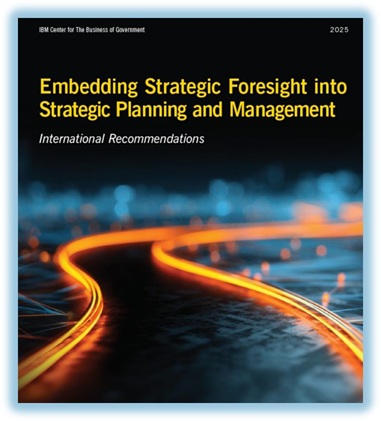
New Research Report: How Governments Can Build More Resilient, Future-Ready Institutions

The IBM Center for The Business of Government is pleased to announce the publication of Embedding Strategic Foresight into Strategic Planning and Management: International Recommendations by Professor Bert George from the City University of Hong Kong's Department of Public and International Affairs.
Why This Report Matters Now
In an era of accelerating change and unprecedented complexity, governments worldwide face a critical challenge: governing not just for today, but for tomorrow. Reactive governance is no longer sufficient. Public leaders must anticipate, prepare, and adapt to emerging realities with unprecedented speed and sophistication.
Yet despite the growing popularity of strategic foresight tools across government, a significant gap persists. Too often, foresight activities remain isolated from the core strategic planning and management processes that actually drive government decision-making. This disconnect limits the impact of foresight work and diminishes the forward-looking capacity of strategic planning itself.
What Makes This Research Unique
Professor George's report addresses this critical gap by analyzing strategic foresight initiatives across four diverse governmental contexts:
- Strategic Insights and Analyses Team of the Flemish Government (Europe, regional)
- Centre for Strategic Futures of the Singaporean Government (Asia, national)
- Strategic Foresight of the European Commission (Europe, supranational)
- Center for Strategic Foresight of the U.S. Government Accountability Office (federal)
Drawing on expert interviews with practitioners, public administration research, and the author's extensive experience, the report offers 27 concrete, evidence-based recommendations for integrating strategic foresight into ongoing strategic planning and management.
The GovCaPP Framework: A Systems Approach
Rather than advocating for specific foresight tools or techniques, Professor George presents a systemic perspective organized around four foundational elements—what he calls the GovCaPP framework:
Governance
Structures that connect foresight to strategy on a continuous basis, including:
- Embedding foresight experts into top-level strategy teams
- Creating both top-down and bottom-up foresight approaches
- Establishing strong leadership support and clear mandates
- Developing compelling public value statements for foresight work
Capabilities
The right people and skills needed throughout the organization, including:
- Organization-wide training in both foresight and strategic planning
- Small, diverse strategic foresight teams with curiosity-driven experts
- Co-creation skills to engage collective intelligence
- Commitment to being a learning organization
Processes
Embedding foresight into planning cycles and management activities, such as:
- Integrating foresight into strategic planning steps and documents
- Supporting whole-of-government strategic initiatives
- Creating early warning systems and dynamic dashboards
- Conducting foresight during annual strategy reviews, not just initial planning
Practice
Ensuring foresight is useful for actual decision-makers through:
- Continuous attention to end-user needs
- Political astuteness and managing organizational politics
- Maintaining neutrality while being actionable
- Enhancing inclusiveness and transparency in strategy processes
Key Insights for Practitioners
The report reveals several important findings from successful practice:
- Strategic foresight should create productive discomfort. As Professor George notes, "If integrating strategic foresight into strategic planning and management feels comfortable, you're not doing it right!" Foresight should push people out of comfort zones, encourage constructive conflict, and challenge assumptions.
- Small teams can have big impact. All four cases studied worked with relatively small core teams—typically 6-17 people—that leveraged broader networks of experts. This approach provides agility and flexibility while managing resources sustainably.
- Bottom-up matters as much as top-down. Effective foresight is both demand-driven (responding to strategic priorities) and supply-driven (identifying blind spots and emerging issues). Decentralized foresight representatives throughout government complement central teams.
- Usefulness is paramount. Strategic foresight must continuously demonstrate its value to end users through public value statements, concrete examples, and evidence of impact. Without relevance to real-world decision-making, foresight risks becoming just another budget line item during cutbacks.
Who Should Read This Report
This report provides invaluable guidance for:
- Public administrators seeking to strengthen anticipatory capacity
- Strategic planners looking to make their processes more future-oriented
- Policymakers wanting to navigate complexity more effectively
- Foresight practitioners aiming to increase their strategic impact
- Government leaders building more resilient institutions
The Path Forward
Professor George emphasizes that successful integration requires sustained commitment and continuous adaptation rather than one-time implementation. The report provides both a comprehensive framework and practical checklist that organizations can use to assess and strengthen the connections between their foresight and planning activities.
As noted in the foreword of this report, "When strategic foresight and strategic planning work in concert, they create a powerful engine for adaptive governance—one that our increasingly complex world desperately needs."
Download the Report
The full report, including all 27 recommendations and detailed case analyses, is available now at businessofgovernment.org.



